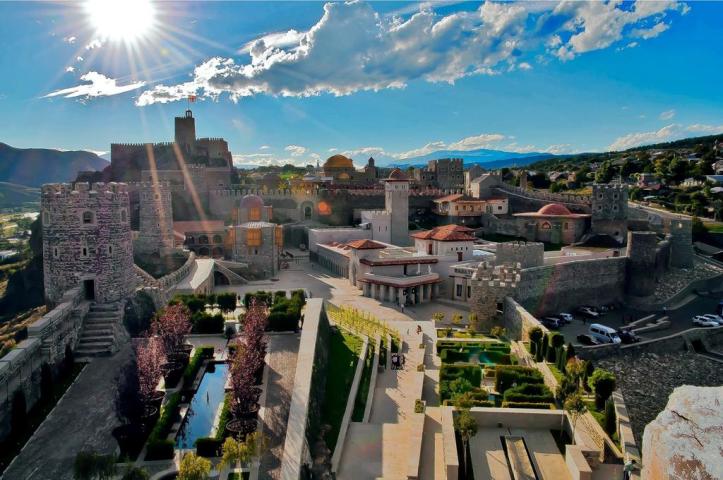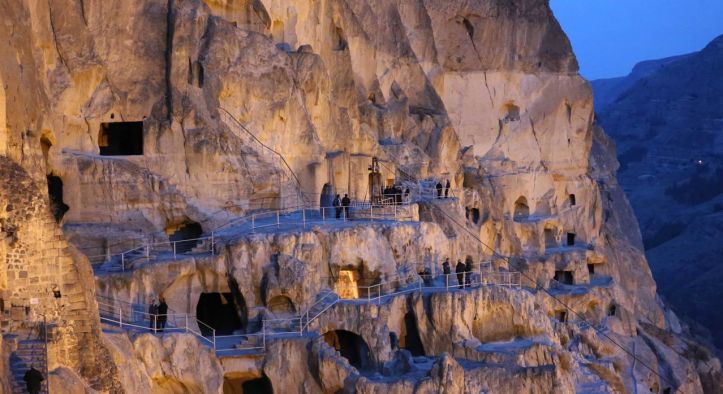
 Borjomi
Borjomi
Resort town in south-central Georgia with a population of 10,546. It is one of the districts of the Samtskhe-Javakheti region and is situated in the northwestern part of the region in the picturesque Borjomi Gorge on the eastern edge of the Borjomi-Kharagauli National Park. The town is famous for its mineral water industry (which is the number one export of Georgia), the Romanov summer palace in Likani, and the World Wide Fund for Nature-site Borjomi-Kharagauli National Park. Borjomi mineral water is particularly well known in those countries which were part of the former Soviet Union; the bottling of mineral water is a major source of income for the area. Because of the supposed curative powers of the area’s mineral springs, it is a frequent destination for people with health problems. Borjomi is also home to the most extensive ecologically-themed amusement park in the Caucasus.
In the Middle Ages, the area of what is now Borjomi was part of the Tori province. It was populated by a series of forts guarding the strategic crossroad of routes leading to the western, eastern, and southern provinces of Georgia. Three important forts – those of “Gogia”, “Petra”, and “Sali” – still overlook the town from nearby hills. From the 16th century into the 19th, the area belonged to the noble family of Avalishvili, but was largely depopulated as a result of Ottoman inroads. After the Russian annexation of Georgia, the Borjomi area began to revitalize. The toponym Borjomi is first recorded in the 1810s. The town and its surroundings were placed under the Russian military authorities. Borjomi began receiving soldiers in the 1820s. Buildings and baths began going up in the 1830s. Early in the 1840s, when the Russian Viceroy of the Caucasus Yevgeni Golovin brought his daughter down to partake of the cure, he expedited the official transfer of the waters from the military to civil authorities. The viceroy Mikhail Vorontsov, fascinated by local landscape and mineral waters, made Borjomi his summer residence and refurnished it with new parks. Its warm climate, mineral water springs, and forests made Borjomi a favorite summer resort for the aristocracy, and gave it its popular name of “the pearl of Caucasus”. In the 1860s, new hotels were built, and an administration for mineral waters was established. In 1871, Borjomi was bestowed upon the royal family member, Grand Duke Mikhail Nikolayvich, then the viceroy of the Caucasus. In the 1890s, Mikhail’s son, Nikolay, built a park and a chateau at Likani, at the western end of Borjomi. The bottled mineral waters began to be extensively exported. The town grew significantly at the expanse of Russian migrants and, in 1901, the number of ethnic Russian inhabitants (2,031) outstripped the native Georgians (1,424) for the first time.

Rabath is a medieval castle complex in Akhaltsikhe, Georgia. Built in the 9th century, initially it was called the Lomisa Castle until it was conquered by Ottomans.
According to the Georgian Chronicles the city was established in the 9th century by Guaram Mampal, son of the King of Tao. From the 13th to the end of 14th centuries it was the capital city of Samtskhe-Saatabago, ruled by the Georgian princely (mtavari) family and a ruling dynasty of the Principality of Samtskhe, the House of Jaqeli.
In 1393 the city was attacked by the armies of Tamerlane. Despite the Turko-Mongol invasions fortress withstood and continued to thrive. After the Treaty of Constantinople in 1590, the whole territory of Samtskhe-Saatabago went under the rule of Ottoman Empire. Turks Mostly used to build defensive edifices. In 1752 first mosque was built in Rabati.
By the end of the 18th century Metropolitan John writes that “despite the fact that a large part of the population has been Islamized, there’s still a functioning Orthodox church”. After the Treaty of Georgievsk between the Kingdom of Kartli and the Russian Empire was signed, the question of the fate of Akhaltsikhe arose. The first attempt to take the fortress in 1810 fell. Russians took the city after 18 years in 1828. After the Treaty of Adrianople in 1829, the Ottomans yielded part of Akhaltiske Region.

Vardzia
Vardzia is a cave monastery site in southern Georgia, excavated from the slopes of the Erusheti Mountain on the left bank of the Kura River, thirty kilometres from Aspindza. The main period of construction was the second half of the twelfth century. The caves stretch along the cliff for some five hundred metres and in up to nineteen tiers. The Church of the Dormition, dating to the 1180s during the golden age of Tamar and Rustaveli, has an important series of wall paintings. The site was largely abandoned after the Ottoman takeover in the sixteenth century. Now part of a state heritage reserve, the extended area of Vardzia-Khertvisi has been submitted for future inscription on the UNESCO World Heritage List.
Soviet-era excavations have shown that the area of Vardzia was inhabited during the Bronze Age and indicated the reach of Trialeti culture. Cave settlements such as Uplistsikhe are known along the Kura River from at least the fifth century BC, while rock cut architecture in the context of Georgian Christianity is known from Zedazeni and Garedzhi from the sixth century AD, and more locally from Vanis Kvabebi, Cholta and Margastani from the eighth century. Four distinct building phases have been identified at Vardzia: the first during the reign of Giorgi III (1156–1184), when the site was laid out and the first cave dwellings excavated; the second between his death and the marriage of his successor Tamar in 1186, when the Church of the Dormition was carved out and decorated; the third from that date until the Battle of Basian c.1203, during which time many more dwellings as well as the defences, water supply, and irrigation network were constructed; while the fourth was a period of partial rebuilding after heavy damage in the earthquake of 1283. A number of documentary sources supplement the knowledge derived from the site’s physical fabric. The collection of chronicles known as the History of Georgia refers to Tamar erecting a church to house the icon of the Virgin of Vardzia after receiving divine help in her campaigns, before transferring the monastery from Upper or Zeda Vardzia. Tamar is said to have departed from Vardzia during her campaign against the Muslims, and her ensuing victory at Basian is celebrated in the Hymns in Honour of the Virgin of Vardzia by Ioane Shavteli. The History of Georgia also relates how Vardzia escaped the Mongol invaders in the 1290s. The Persian Safavid chronicler Hasan Bey Rumlu describes Vardzia as a “wonder”, “impregnable as the wall of Alexander the Great”, before recounting its sack by the Persians under Shah Tahmasp I in 1551; a near-contemporary note in the Vardzia Gospel tells of its repatriation from a Persian bazaar. After the arrival of the Ottomans in 1578, the monks departed and the site was abandoned.

Borjomi, Rabath, Vardzia – восхитительный тур, организован на высшем уровне!!! Комфортабельная машина с кондиционером, замечательный экскурсовод Анзор, который разговаривает на грузинском, русском и английском языках, прекрасно знает историю Грузии и с радостью делится своими знаниями!
От окружающей природы невозможно отвести глаза! Всё наполнено красотой, гармонией и жизнерадостностью! Borjomi, Rabath, Vardzia – это три места, которые обязательно советую увидеть, путешествуя по Грузии!!!
LikeLiked by 1 person